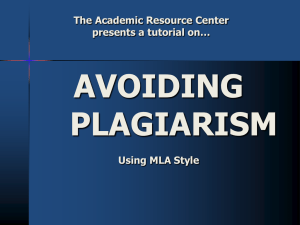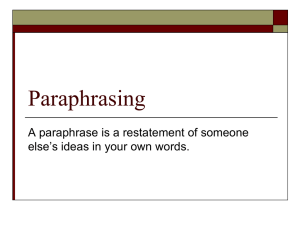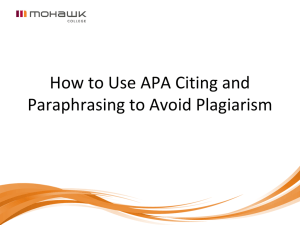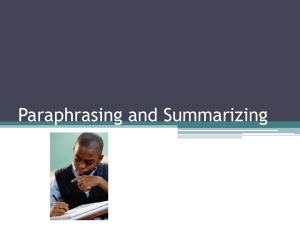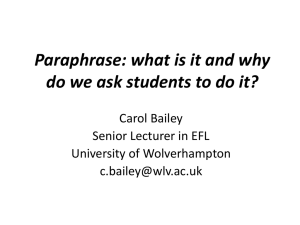LESSON PLAN Quoting Paraprasing and Summarizing
advertisement
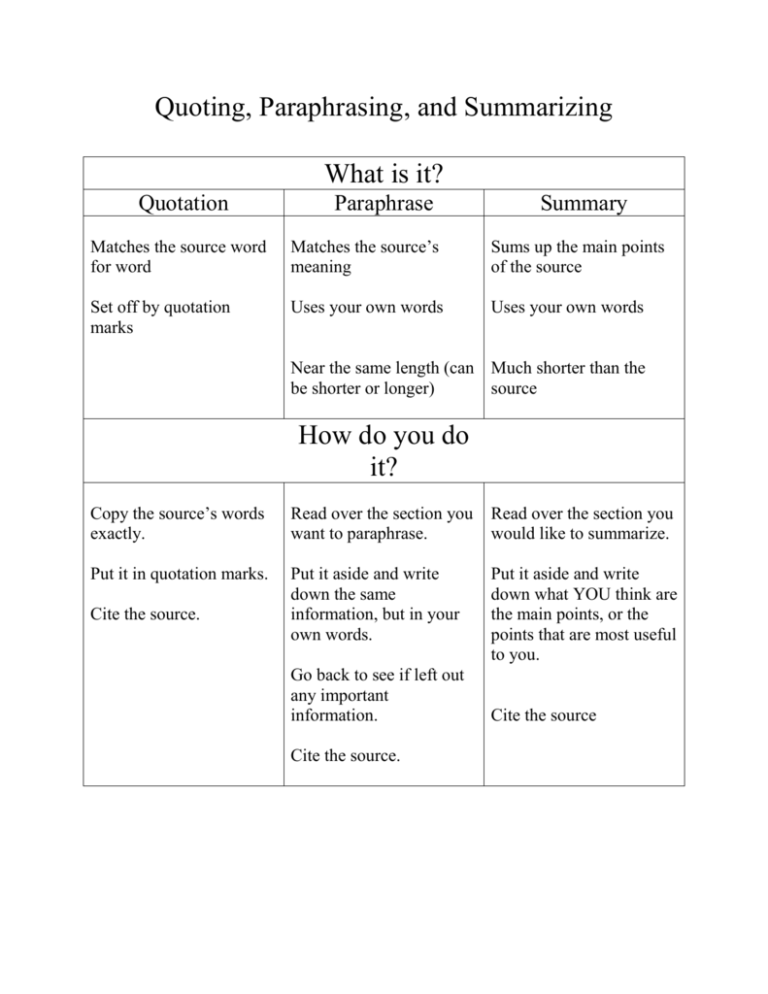
Quoting, Paraphrasing, and Summarizing What is it? Quotation Paraphrase Summary Matches the source word for word Matches the source’s meaning Sums up the main points of the source Set off by quotation marks Uses your own words Uses your own words Near the same length (can Much shorter than the be shorter or longer) source How do you do it? Copy the source’s words exactly. Read over the section you want to paraphrase. Read over the section you would like to summarize. Put it in quotation marks. Put it aside and write down the same information, but in your own words. Put it aside and write down what YOU think are the main points, or the points that are most useful to you. Cite the source. Go back to see if left out any important information. Cite the source. Cite the source Original passage Students frequently overuse direct quotation in taking notes, and as a result they overuse quotations in the final [research] paper. Probably only about 10% of your final manuscript should appear as directly quoted matter. Therefore, you should strive to limit the amount of exact transcribing of source materials while taking notes. Source: Lester, J. D. (1976). Writing Research Papers (2nd ed.). pp. 46-47. Quote 1 Quote 2 Probably only about 10% of your final manuscript should appear as directly quoted matter. “Probably only about 10% of your final manuscript should appear as directly quoted matter.” (Lester, 1976). Source: Purdue University Online Writing Lab, Paraphrase: Write it in Your Own Words, located at: http://owl.english.purdue.edu/handouts/research/r_paraphr.html Original passage Students frequently overuse direct quotation in taking notes, and as a result they overuse quotations in the final [research] paper. Probably only about 10% of your final manuscript should appear as directly quoted matter. Therefore, you should strive to limit the amount of exact transcribing of source materials while taking notes. Source: Lester, J. D. (1976). Writing Research Papers (2nd ed.). pp. 46-47. Paraphrase 1 Students often use too many direct quotations when they take notes, resulting in too many of them in the final research paper. In fact, probably only about 10% of the final copy should consist of directly quoted material. So it is important to limit the amount of source material copied while taking notes. Paraphrase 2 In research papers students often quote excessively, failing to keep quoted material down to a desirable level. Since the problem usually originates during note taking, it is essential to minimize the material recorded verbatim (Lester, 1976). Source: Purdue University Online Writing Lab, Paraphrase: Write it in Your Own Words, located at: http://owl.english.purdue.edu/handouts/research/r_paraphr.html Students often use too many direct quotations when they take notes, resulting in too many of them in the final research paper. In fact, probably only about 10% of the final copy should consist of directly quoted material. So it is important to limit the amount of source material copied while taking notes. Original passage Students frequently overuse direct quotation in taking notes, and as a result they overuse quotations in the final [research] paper. Probably only about 10% of your final manuscript should appear as directly quoted matter. Therefore, you should strive to limit the amount of exact transcribing of source materials while taking notes. Source: Lester, J. D. (1976). Writing Research Papers (2nd ed.). pp. 46-47. Summary 1 Summary 2 Students often use too many direct quotes when taking notes, which leads to too many quotations in their final paper. Quotes should only make up about 10% of the whole work. J.D. Lester warns students that using too many direct quotes when taking notes will lead to too many quotations in their final paper. Quotes should only make up about 10% of the whole work. (Lester, 1976). Source: Purdue University Online Writing Lab, Paraphrase: Write it in Your Own Words, located at: http://owl.english.purdue.edu/handouts/research/r_paraphr.html Rick Reilly, “Give Casey Martin A Lift” Sports Illustrated Quotes: “Casey Martin has a right leg two sizes too small and a heart three sizes too big” (Reilly). Paraphrase: “I hear old guys wheezing on about Ben Hogan's having to walk during his comeback after crashing into a bus. Do you think what Martin has done is any less brave? He suffers from a rare circulatory disorder, and doctors say his condition is "worsening." The minute he takes the two support stockings off his right leg, it swells up like a bagpipe. He's in pain 24 hours a day, so now he has trouble sleeping too. During his swing he turns on a leg as skinny as a Little Leaguer's bat. Yet he won the Lakeland Classic on the Nike tour last month. What, only Hogan gets to be a legend?” Some argue that other golfers had to walk the course while injured, but Martin deserves a special exception. His circulatory issues worsen every day causing swelling, constant pain, and many sleepless nights. His wins at the Lakeland Classic and the Nike tour prove he has a future in golf; we shouldn’t take that away from him because he can’t walk (Reilly). Summary: In “Give Casey Martin a Lift,” Rick Reilly argues the case of golfer Casey Martin. A rare disorder prevents him from walking long distances, and Reilly believes Martin should be provided a cart. He disagrees with the PGA Tour’s desire to keep the traditions of the game, claiming that golf is not a sport of walking and that allowing the use of a cart will not give Martin an unfair advantage over other players (Reilly). LESSON PLAN 3 PLANNING Date: February 23, 2009 Class and Grade Level: English 11 Title/Subject of Lesson: Plagiarism Objective(s): Students will be able to avoid plagiarism through the proper paraphrasing and quoting of information. State (or District) Core Curriculum Standard(s): Standard 1, Objective 2, c: Synthesize information from a variety of sources. 2, 2, c: Support arguments with logic and text references. 3, 1, d: Evaluate, use, and cite primary and secondary sources. Concept(s) to Be Taught: paraphrasing, quotation, plagiarism. Materials Needed: Overheads and transparencies. Strategies to Be Used: modeling, discussion, activating prior knowledge, independent practice. PERFORMING Announcements: none Continuation from Previous Lesson: Students have begun a research paper and they have been gathering sources in the previous classes. Lesson Presentation: A) Getting Started: [anticipatory set] Bellstarter: “What are some things students do to cheat on their assignments? Does it hurt anyone when people cheat? What are the usual punishments for cheating? Do you agree or disagree? Why?” Ask students to discuss what they wrote. Prompt them with questions from the Bellstarter if they aren’t participating. Make sure to emphasize who is hurt by cheating (their classmates who actually did the work, the person whose work they took, themselves because they are dishonest and they don’t learn anything.) Ask the students to give you examples of how someone might cheat on a research paper. (Turning in someone else’s paper with their name on it, buying a paper from the internet and turning it in, revising either of the other two examples and putting you Introduce the term “plagiarism.” Plagiarism is a fancy term for everything we have been discussion. Ask the students to come up with a class definition taken from the discussion. Write on the board the suggestions they make and synthesize them into one definition. Finally, ask the students if they think it is possible to plagiarize by accident. How might one do that? How is that different from purposeful plagiarism. If the students can’t think of an example, tell them that the most common form of plagiarism is done completely by accident. Students do research and then they don’t properly give credit for it in their final paper. Tell the students that today they will learn some strategies on how to avoid accidental plagiarism. B) Directing the Learning: [learning activities] Tell the students that you will be learning how to avoid plagiarism through quoting, paraphrasing, and summarizing. Put up the first overhead that discusses the definitions of each and walk the students through it. Put up the overhead with examples of quotes and ask students the difference between the two quotes. Make sure they understand the problems with the first quote and how the second quote follows the proper citation rules. Next put up the paraphrase examples. Cover the sentence at the bottom and ask the students the problem with the first paraphrase. (The paragraph is copied and pasted with only a few phrases changed. They give no mention of where they go their information.) Compare the two paraphrases again. What is different about the second one? Explain to the students that a paraphrase is not simply changing a few words around. A paraphrase is rewriting the sentence in their own words. Make the analogy of a game of telephone or when stories pass from friend to friend. The basic information stays the same, but each teller adds their own style or flair. Put the summary overhead up and ask the students to compare the two summaries. Put the first overhead back on the board so the students see the differences between a paraphrase and a summary. Ask the students when they might need to use a quote or a paraphrase. When might we need to use a quote in our research paper? (When an author says something short that is really profound.) When might we need to use a paraphrase? (When we need to share a few ideas from the author.) Now it is time to practice. Put the students in pairs and give them a copy of “Hello, Moon.” They will produce a quote paraphrase, and summary of the article before they may go to the computer lab. C) Bringing the Lesson to a Conclusion: Walk around the classroom checking on students. Release them to the lab when they are done. Assignment: Three notecards must be stamped by the end of the period.
